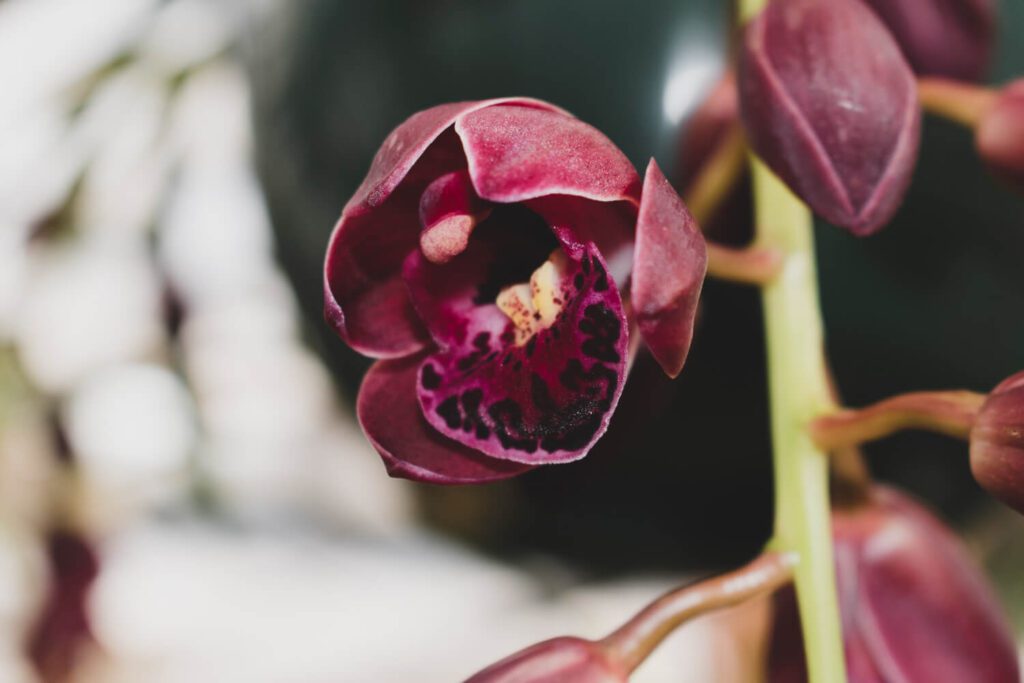it is very important to know which kind of orchids you are trying to grow as it is the key to its cultural requirements. Orchids, need a balance of light, air, water and food to grow and flower well. Let’s find out each of these elements.

Light
Without sufficient light, orchids may produce lush looking growths but no flowers. Not giving enough light to orchids is the most common reason for failure to bloom. The old belief of orchids growing in dark jungles still continue to exist and it couldn’t be further from the truth.
How much light is sufficient? The answer to this apparently easy question is “as much as they will take without burning.” This means that the leave should not be a lush, dark green. Orchids grown under enough light will have lighter, somewhat yellow-green leave and strong upright growths. Figure1 describes two cattleyas, one grown under most suitable light conditions and the other under too little light to produce flowers.
Air
Orchids roots, and eventually the whole plant, will die if they do not receive air and this is the reason which, with the exception of a few terrestrial varieties, orchids do not grow in soil. Orchid potting media should be open, with exceptionally good drainage, but capable of keeping enough moisture to support the plant’s needs. Orchid plants are also intolerant of an unpleasant, stagnant environment. You should strive for a buoyant atmosphere and gentle air movement must be always provided. home grown orchids can provide an overhead paddle fan which is then set to its lowest setting or you can think of a portable fan directed AWAY from the plants.
Without question, more orchids are killed by wrong watering than by any other reasons. Suitable watering consists of two separate components; quantity and frequency. Orchids should be watered only when they dry out. There’s unfortunately no magic formula; i.e., water a plant in a 6″ pot every 7 days and you’ll be trouble free. Humidity, potting medium, air movement,and light levels all play a role. There are many ways to establish when a potted orchid is almost dry: you can check the surface of the potting mix, also the drier pots will be much lighter; the pots made of clay feel dry. If in doubt, a finger inserted into the potting mix is perhaps the best tool to establish the moisture content of the potting mix. It will cause no harm to the plant.
When orchids are watered, they should be watered sufficiently. Water should be given till it flows freely from the drainage holes. Not only does this soaks the potting medium but it also flushes salts that naturally accumulate. At a minimum, try to thoroughly water your plants at least once a month.
Watering frequency can be controlled by the selection of pot. For those who really like to water their plants or live in humid, rainy areas, clay pots, particularly slotted pots are a good selection. Growers in drier weather conditions or those who tend not to water frequently sufficient might want to use plastic pots to keep moisture longer.
Orchids will grow and flower, given that their other requirements are met, for quite long periods without fertilizer but you will receive better results with some level of feeding (Figure 3). Generally, plants are fertilized once a week during the summer and every two weeks in the fall and winter. Regardless of the fertilizer that you select to use, most experienced growers use no more than ½ the label-recommended strength. Oh, and by the way, it’s best to water first in order to make the potting medium wet before you fertilize.
Fertilizers used on orchids should have little or no urea. This is because soil organisms must first convert the nitrogen in urea to a form useable by plants, and because orchids do not grow in soil, this conversion does not occur efficiently. Previously we used to think that orchids need to be grown in bark mixes and need to be fertilized with formulations high in nitrogen, i.e., 30-10-10. Now, we understand that these high nitrogen fertilizers aren’t necessary.
Most experienced growers will agree that observation is the most crucial factor to growing orchids well. Examining your plants on a regular basis will allow you to adjust and correct any problems before they become very serious. In subsequent articles we will look at thoroughly and carefully in more detail these four elements of culture and the orchid genera more commonly found in the marketplace.
